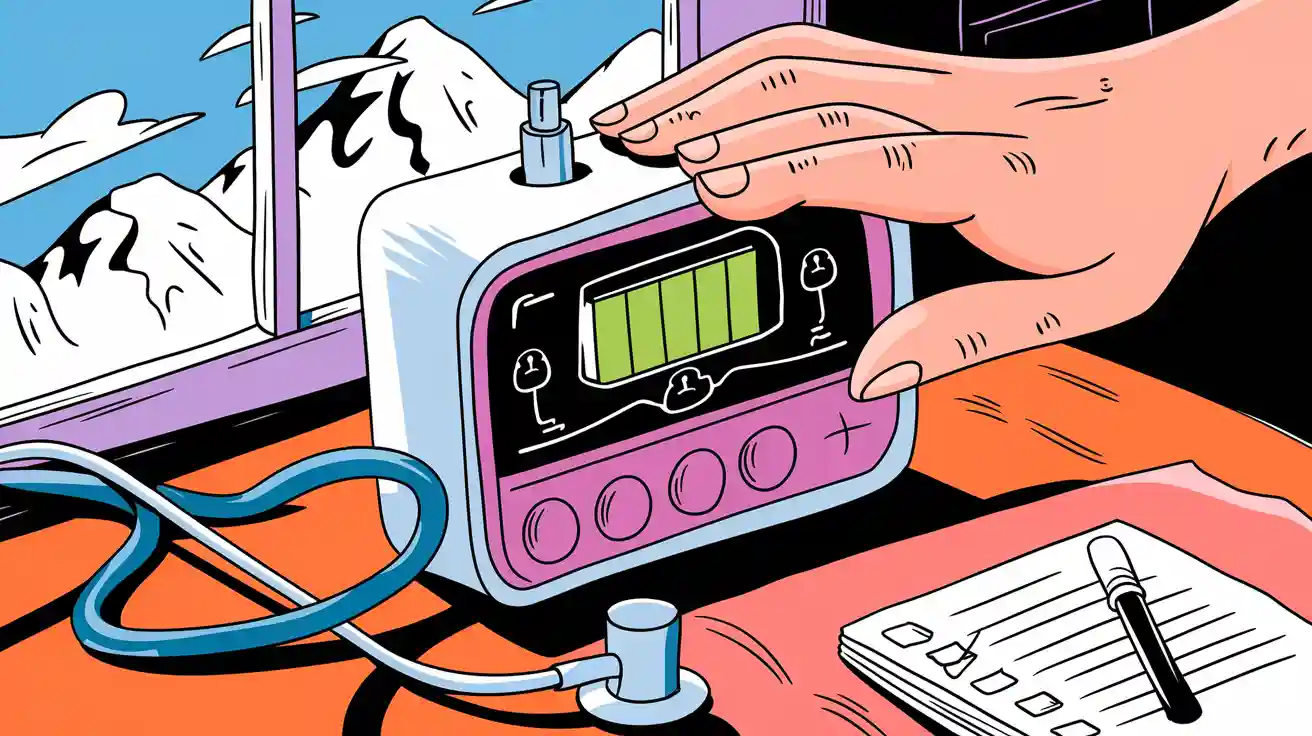
You must address high-altitude risks for lithium battery packs in medical devices. Select cells designed for low pressure and cold. Maintain optimal temperature with active thermal management. Use real-time monitoring for voltage and temperature. Proactive steps help you avoid failures, as shown in the Case Study on Performance Optimization of Medical Batteries in High Altitude and Low Temperature Env.
Key Takeaways
Select lithium batteries designed for low pressure and cold temperatures to ensure reliable performance in high-altitude medical devices.
Implement effective thermal management strategies, such as insulation and active cooling, to maintain optimal battery temperatures and prevent thermal runaway.
Continuously monitor battery conditions using advanced technologies to detect issues early and ensure long-term reliability in critical medical applications.
Part 1: Environmental Challenges

1.1 Low Pressure Risks
You face several risks when operating lithium battery packs at high altitudes. Low air pressure can disrupt the internal electrochemical reactions, which affects how your battery stores and releases energy. The physical integrity of the battery becomes vulnerable. Swelling, leakage, and venting may occur due to pressure imbalances. Reduced oxygen levels increase internal resistance, which lowers power delivery efficiency. You also encounter a higher risk of thermal runaway because heat dissipation becomes less effective.
Risk Type | Description |
|---|---|
Chemical Behavior | Low air pressure alters internal electrochemical reactions, affecting energy storage and release. |
Efficiency and Output | Reduced oxygen levels increase internal resistance, diminishing power delivery efficiency. |
Physical Integrity | Risks of swelling, leakage, and venting due to internal pressure imbalances. |
Thermal Runaway | Reduced heat dissipation and temperature fluctuations increase the risk of thermal runaway. |
1.2 Low Temperature Effects
Low temperature presents a major challenge for lithium battery packs in medical devices. You will notice a reduction in available capacity. Charge and discharge power become limited, which can cause irreversible capacity loss. Increased internal resistance makes ion diffusion more difficult, rapidly decreasing battery capacity. Charging below 0°C is not recommended because lithium plating may occur on the anode, leading to dendrite formation and possible short circuits. Low temperature also increases the risk of permanent damage during charging cycles.
Low temperature reduces available battery capacity.
Charge and discharge power are limited, risking irreversible capacity loss.
Increased internal resistance makes ion diffusion more difficult.
Charging below 0°C can cause lithium plating and dendrite formation.
Large Power’s low-temperature battery solutions ensure your device operates reliably under the required conditions.
1.3 Combined Impact on Lithium Batteries
You must understand how low temperature and low pressure interact to affect battery reliability. Low temperature increases electrolyte viscosity, which hinders battery performance. Reduced ionic conductivity leads to lower efficiency. Irreversible capacity loss becomes more likely, threatening the reliability of your medical device. Low temperature can also trigger thermal runaway, where the battery’s internal temperature rises uncontrollably due to exothermic reactions. You need to recognize these combined risks to ensure safe and reliable operation of lithium battery packs in high-altitude medical environments.
Tip: Always monitor both temperature and pressure conditions to prevent unexpected battery failures in critical medical applications.
Part 2: Performance Optimization Strategies
2.1 Battery Selection
Selecting the right lithium battery chemistry is the foundation for reliable performance in high altitude lithium battery applications. You must evaluate battery types based on stability, cycle life, and cold-weather performance. The table below compares the most common chemistries used in medical devices:
Battery Type | Stability | Cycle Life | Performance in Cold Conditions |
|---|---|---|---|
LiFePO4 | High | 2,000–5,000 cycles | Outperforms NMC and LCO |
NMC | Moderate | Varies | Less effective |
LCO | Low | Varies | Less effective |
LiFePO4 batteries deliver superior stability and longevity, making them ideal for medical devices operating in high altitude and low temperature environments. You should also consider design features that enhance safety and reliability. The following table outlines essential design elements for high altitude lithium battery packs:
Design Feature | Description |
|---|---|
Safety Mechanisms | Batteries must pass rigorous UN-T transportation tests to ensure reliability at high altitudes. |
Accurate State-of-Charge Indicators | Sophisticated fuel-gauge ICs help predict remaining battery capacity accurately. |
Rigorous Testing | Ensures batteries can withstand low pressure, thermal cycling, and other environmental factors. |
Short-circuited lithium-ion batteries are engineered to smolder and extinguish instead of igniting, which enhances safety in critical medical applications.
Recent advancements in lithium battery technology include predictive models for cycle life using machine learning. These models analyze performance data to improve the safety and reliability of high altitude lithium battery packs, especially in medical devices that require high energy density.
2.2 Thermal Management
Effective thermal management is essential for maintaining battery performance in cold, low-pressure environments. You can use several strategies to keep your high altitude lithium battery within optimal temperature ranges:
Insulation shields batteries from external temperature swings, maintaining a stable internal environment.
Nano-Enhanced Phase Change Materials (NEPCMs) improve thermal conductivity and regulate temperature more efficiently than traditional materials.
Heating plates and active cooling systems provide precise temperature control, which is crucial for medical devices in extreme conditions.
Tip: Combine insulation with NEPCMs for the best results in high altitude and low temperature environments. This approach ensures your battery remains within safe operating limits, reducing the risk of thermal runaway.
2.3 Storage and Operation
Proper storage and operation protocols extend the lifespan and safety of your high altitude lithium battery. You should simulate low pressure conditions during testing, similar to those found in unpressurized airplane cargo areas at altitudes up to 15,000 meters. Store batteries at a pressure of 11.6 kPa for at least six hours. After testing, ensure there is no mass loss, leakage, venting, disassembly, rupture, or fire. The battery voltage must remain within 10% of the pre-test value.
Charging protocols play a critical role in battery longevity and safety. Always follow manufacturer-specified charging instructions. Charge batteries within the optimal temperature range of 10°C to 45°C. Charging outside this range can cause lithium plating or electrolyte decomposition, which increases the risk of failure. Use standard charging rates of 0.5C to 0.7C to maximize lifespan. Higher rates may accelerate degradation and reduce reliability.
For medical devices, you must conduct low pressure testing by placing a fully charged battery in a vacuum chamber at 20°C ± 5°C. Reduce the pressure to 11.6 kPa for six hours. The battery must not ignite, explode, or leak during or after this exposure. This protocol ensures safe operation under reduced atmospheric pressure, which is vital for the case study on performance optimization of medical batteries in high altitude and low temperature env.
2.4 Monitoring and Maintenance
Continuous monitoring and proactive maintenance are vital for high altitude lithium battery reliability. You have access to several advanced monitoring technologies:
Monitoring Technology | Description |
|---|---|
Thermocouples | Traditional temperature measurement; limited by vulnerability and accuracy. |
Resistance Temperature Detectors (RTD) | Conventional method; affected by environmental factors and complexity. |
Electrochemical Impedance Spectroscopy (EIS) | Advanced, non-destructive measurement; does not require temperature sensors. |
Johnson Noise Thermometry (JNT) | Suitable for harsh environments; may have large errors with other sensors. |
Optical Fiber Sensing | Real-time temperature monitoring with high spatial resolution. |
Effective warning strategies are essential for lithium-ion batteries in high altitude applications. You must monitor aging characteristics and thermal runaway parameters to ensure safety.
Optimizing the depth of discharge (DoD) improves battery lifespan, reduces heat generation, and maintains performance stability. Shallow discharges, ideally within 20% to 80% DoD, minimize stress and degradation. Over-discharge can cause irreversible damage and increase safety risks, especially in medical devices.
Battery Management Systems monitor DoD and prevent over-discharge, which is critical for the case study on performance optimization of medical batteries in high altitude and low temperature env.
You must also follow strict safety protocols to prevent swelling, leakage, or explosion:
Safety Protocols | Description |
|---|---|
Proper Handling | Follow guidelines for safe handling to prevent accidents and risks. |
Quality Assurance | Implement rigorous testing and adhere to standards to minimize defects. |
Safe Usage | Use specific charging instructions and avoid overcharging to prevent hazards. |
Regulatory Standards | Comply with regulations for safe handling, storage, and transportation. |
Note: Adhering to these protocols ensures your high altitude lithium battery packs meet the highest safety and reliability standards, as demonstrated in the case study on performance optimization of medical batteries in high altitude and low temperature environment.
By applying these strategies, you can optimize the performance and safety of lithium battery packs in medical devices. The case study on performance optimization of medical batteries in high altitude and low temperature env highlights the importance of battery selection, thermal management, and continuous monitoring for reliable operation.
Part 3: Case Study on Performance Optimization of Medical Batteries in High Altitude and Low Temperature Environment

3.1 Real-World Application
You can see the impact of battery optimization strategies in the PB560 ventilator, a portable medical device designed for use in challenging environments. This ventilator relies on a lithium-ion battery pack managed by an advanced battery management system (BMS). The BMS prevents deep discharges and overcharging, which protects the battery and extends its lifespan. Healthcare practitioners receive real-time alerts about battery status, allowing them to respond quickly during emergencies. In high altitude settings, where power supply can be unpredictable, this system ensures continuous patient care.
Manufacturers use high altitude test chambers to simulate low atmospheric pressure conditions. These chambers help you identify how lithium battery packs perform when exposed to pressure changes and cold temperatures. Devices like ventilators and electrocardiographs undergo rigorous testing to confirm reliability. You can learn more about medical battery solutions for these scenarios.
The PB560 ventilator demonstrates how a well-designed BMS and thorough environmental testing can optimize battery performance and safety in high altitude medical applications.
3.2 Lessons Learned
You gain several key insights from this case study:
Advanced BMS technology improves patient safety by providing accurate battery status and preventing failures.
High altitude test chambers are essential for validating battery reliability in low pressure and cold environments.
Real-time monitoring and alerts enable healthcare teams to maintain uninterrupted care, even when external power sources are unstable.
Best Practice | Benefit |
|---|---|
Use of BMS | Extends battery life, prevents deep discharge |
Environmental Testing | Ensures reliability under extreme conditions |
Real-Time Alerts | Supports rapid response in emergencies |
You should prioritize battery management and environmental testing when designing lithium battery packs for medical devices in high altitude regions. These strategies help you deliver reliable, safe, and effective solutions for critical healthcare applications.
You ensure reliable lithium battery packs in medical devices at high altitudes by selecting the right chemistry, applying robust thermal management, and using continuous monitoring. Monitoring supports long-term reliability:
Application | Contribution to Reliability |
|---|---|
Thermal runaway detection | Early warning prevents failures, improving safety and reliability. |
State of charge estimation | Optimizes charging and depth of discharge, extending battery life. |
Mechanical stress monitoring | Detects damage or fatigue early, supporting long-term performance. |
Use a checklist for ongoing risk management and consistent performance.
FAQ
What makes Large Power’s lithium battery packs suitable for high-altitude medical devices?
Large Power designs custom battery solutions for medical devices. You get batteries tested for low pressure, cold, and reliability.
How do you compare LiFePO4 and NMC chemistries for cold environments?
Chemistry | Stability | Cycle Life | Cold Performance |
|---|---|---|---|
High | 2,000–5,000 | Superior | |
NMC | Moderate | Varies | Less effective |
LiFePO4 offers better cold performance and longer life.
Can you use Large Power’s battery packs in robotics or security systems at high altitudes?
Yes. Large Power customizes lithium battery packs for robotics, security systems, and industrial sectors. You get reliable performance in extreme conditions.




